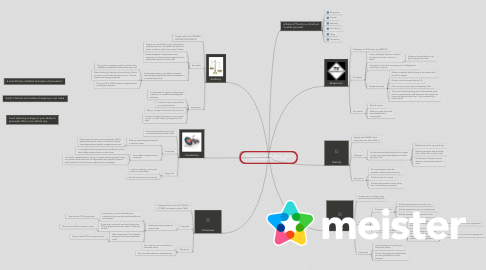
1. It will make big changes in your ability to persuade others in an ethical way
2. Small, Practical and costless changes you can make
3. Consensus
3.1. People will look to the ACTIONS of OTHERS to determine their OWN
3.2. Examples
3.2.1. Hotels persuading guests to reuse towels
3.2.1.1. some place a card in the bathroom explaining how reusing towels benefits the environment
3.2.1.1.1. They achieve 15% compliance
3.2.1.2. A test was carried out and when they write 75% of guests reuse their towels - Please do as well!
3.2.1.2.1. They achieve 26% increase in reuse
3.2.1.3. When they write 75% of people staying in this room reuse their towel
3.2.1.3.1. They achieved 33% increase in reuse
3.3. Key points
3.3.1. Don't rely on your own ability to persuade others
3.3.2. Point to what others are already doing
4. Authority
4.1. People will follow CREDIBLE KNOWLEDGE EXPERTS
4.2. Examples
4.2.1. People are more likely to give change for a parking meter to a complete stranger if he wears a uniform rather than casual clothes
4.2.2. Physiotherapists can persuade more customers to follow exercise regimes if they display their diploma on the wall
4.2.3. A real estate agency was able to increase their property appraisals and the subsequent contracts they wrote
4.2.3.1. They got the reception staff to mention their colleagues credentials before directing a call
4.2.3.2. When looking for lettings, she would say 'let me connect you with Sandra who has over 15 years experience letting properties'
4.2.3.3. They got 15 to 20% increase in appointments and signed contracts
4.3. Key points
4.3.1. It's important to signal to others what makes you a credible knowledgeable authority
4.3.2. It is hard to go around telling your customers this
4.3.3. But you can get someone to do it for you
4.3.4. It doesn't matter if the person is connected to you or is also likely to prosper fromt he deal
5. Consistency
5.1. Looking for and asking for small commitments that can be made
5.2. Examples
5.2.1. Reduce missed appointments at a medical center
5.2.1.1. Missed appointments were reduced by 18% by getting the patient rather than staff to writing down appointment details on appintment card
5.2.2. Drive safely neighbourhood campaign
5.2.2.1. In a neighbourhood people were unwilling to place a drive safely wooden board on their lawn
5.2.2.2. In a similar neighbourhood, 4 times as many people agreed to erect the wooden board because 10 days earlier they agreed to place a small postcard in their window supporting the campaign
5.3. Key points
5.3.1. Look for voluntary, active and public commitments
5.3.2. Get the commitments in writing
6. 6 scientifically validated principles of persuasion!
7. Liking
7.1. People are more likely to say yes to someone that they like
7.2. Examples
7.2.1. 3 important factors
7.2.1.1. We like people who are similar to us
7.2.1.2. We like people who pay us compliments
7.2.1.3. We like people who cooperate with us
7.2.2. A study done in an MBA course
7.2.2.1. One group were told, 'time is money, get straight down to business'
7.2.2.1.1. 55% were able to come to an agreement
7.2.2.2. The other group were told to exchange some personal information about their likes before starting negotiations
7.2.2.2.1. 90% were able to to come to an agreement
7.3. Key points
7.3.1. Look for areas of similarity you share with others
7.3.2. Think of any genuine compliments you can give before you do business
8. 6 Rules of Thumb i.e. shortcuts to what you want
8.1. Reciprocity
8.2. Scarcity
8.3. Authority
8.4. Consistency
8.5. Liking
8.6. Consensus
9. Reciprocity
9.1. Obligation to GIVE when you RECEIVE
9.2. Examples
9.2.1. If your colleague does you a favour you then owe them a favour in return
9.2.1.1. People are more likely to say yes to people the owe!
9.2.2. If someone invites you to a party you're obligated to invite them to yours
9.2.3. Restaurant study
9.2.3.1. Waiter or waitress either brings a mint sweet with the bill or doesn't
9.2.3.2. Giving a mint increased tips by 3%
9.2.3.3. If two mints are given tips increased by 14%
9.2.3.4. The most interesting thing was: if the waitress gives one mint and starts to walk away but then stops and returns to offer another mint - tips increased by a massive 23%
9.3. Key points
9.3.1. Be first to give
9.3.2. What you give should be personalised and unexpected
10. Scarcity
10.1. People want MORE of the things they can have LESS of
10.2. Examples
10.2.1. Concord announced they would no longer run the twice daily flight between London and New York
10.2.1.1. Sales boomed the very next day
10.2.1.2. Nothing changed with the flight time or the route or the air fare
10.2.1.3. Just became it became scarce resource and people wanted it more
10.3. Key points
10.3.1. Don't just explain what the benefits of your product/ service
10.3.2. Tell them why it is unique
10.3.3. And what they stand to lose if they don't consider your proposal
